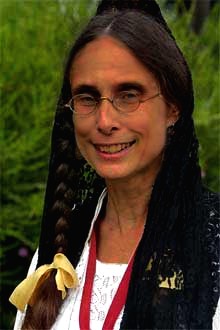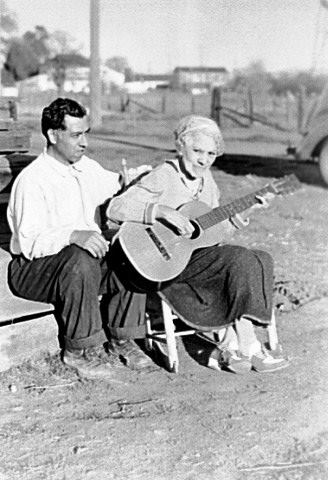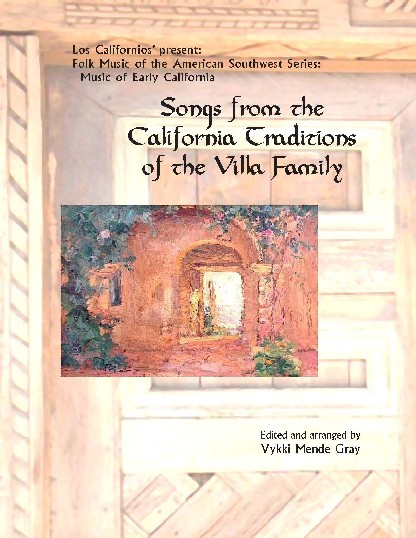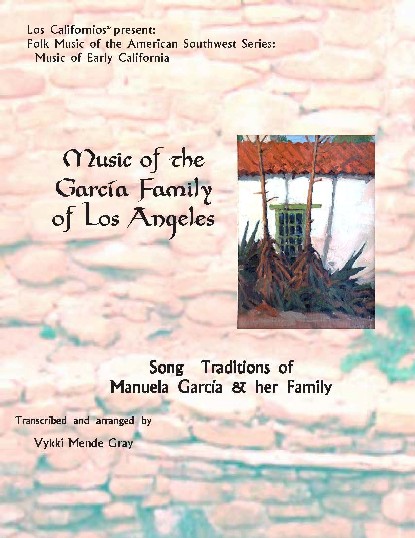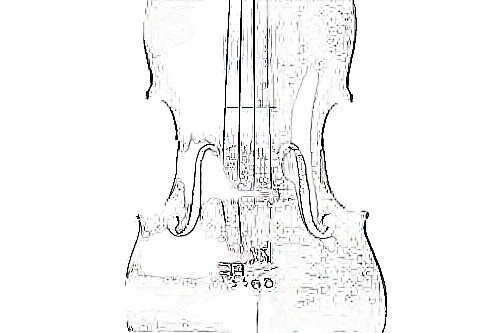Los californios® Home |
Resumé |
Events |
Wares |
Order Form |
Sitemap |
Contact |
Portal
Los californios®, based in San Diego, California, play and sing the secular music of California from the days when our state was part of Spain and then Mexico. These sweet, melodic pieces include waltzes and polkas used for dancing, and songs about love and rancho life, often with comic lyrics. Although the music includes elements of Spanish music, it also includes influences from European and American folk music — as trading ships often visited the coast of Alta California, from the indigenous peoples of California, and from the diverse heritages of the early Mexican settlers. Los californios® is a self-supporting project of San Diego Friends of Old-Time Music, a California non-profit educational corporation. This project works to expose California audiences to their own historic musical heritage; to research, document and transcribe social music and dances from eighteenth and nineteenth century Spanish-speaking Californians; and to teach and distribute this information to a wide audience of musicians, dancers and enthusiasts through workshops, performances, articles and papers presented at educational conferences, and music classes at Sherman Heights Community Center.
For Bookings: Please Contact David Swarens by Phone: (619)232-4475 Los californios® include:
Los californios® received a People in Preservation Award from
Save Our Heritage Organization for these accomplishments. Los californios® is a registered service mark belonging to San Diego Friends of Old-Time Music, Inc. Preserving Californio Social MusicIn the era of Alta (Upper) California, the 5,000 or so settlers lived far apart, spread between San Diego and Sonoma. So when friends and relatives gathered at a rancho for a holiday or visit, it was an occasion for many days of singing, dancing and celebrating.
Over time a number of groups continued in efforts to preserve this California heritage: the Padua Hills Theatre (The Mexican Players) in Claremont, the José Arias Troubadours, Eugene Plummer with his dance group, the folk dance community with dance collectors and teachers like Lucille Czarnowski and Albert Pill, Gabriel Ruíz and his group of musicians and dancers, the A la California Club (later calling itself Los Californios), the Southwest Museum, now part of The Autry Center, and its adjunct the Casa de Adobe, Elisabeth Waldo with her creative compositions based on historic California music, Elizabeth Erro Hvolboll and Luis Moreno, Luis Goena and his dancers Los parientes, Yesteryears Dancers, Arnold Guerra and his dancers Tatalejos, The Alta California Dance Company, The Calicanto Associates, Los Arribeños de San Francisco, Baile de California [also on FaceBook at https://www.facebook.com/ BaileDeCalifornia/], Los Bailadores of Old Town San Diego, Los Califas in Petaluma, El coro hispano de San Francisco, The Alta California Orchestra (TACO), and descendants groups from all over the state. In the late 1930s Sidney Robertson Cowell undertook a project to document Northern California Folk Music and included a number of recordings and photographs of people preserving this tradition of music, including informants like: Lottie Espinosa, Hilda Duarte Brown and Walter Sebree, and Jessie de Soto performing Spanish-language songs from California; and The Boys of St. Joseph’s Seminary, women from the Asistencia at Pala (Pala Indian Reservation), and the Choristers of St. Anthony’s Seminary performing music from California’s Spanish-era missions. In the 1950s folk dance academia found itself to be part of the Physical Education curriculum. Two prominent collectors kept the music and dance alive during this period: Lucille K. Czarnowski (1897-1985) was on the faculty of the University of California at Berkeley from 1923-1973. Her groundbreaking book, Dances of Early California Days, influenced, and continues to influence, generations of dancers.
And many people who today know the 19th-century californio dances and dance music can credit Al Pill (1924-1998), who dedicated much of his life to keeping californio and Mexican traditional dance alive. He taught at California State University at Fullerton until 1988. Late in his life, he was acutely aware of the need to make sure that his dances did not die with him, and reached out to younger persons able to carry on the traditions. Another of those links with the past was Luis Goena of Santa Barbara (1928-2014). A student at one time of Al Pill, Luis made folk music come alive in Santa Barbara for several generations of dancers, including a suite of californio dances with his group Los parientes. In 1989 a group of San Diego folk musicians, organized by Lee Birch and calling itself Los californios®, began playing this music and learning these dances. David Swarens knew of Lummis’ original recordings housed at the Southwest Museum in Los Angeles (a museum that Lummis had helped to found in 1914) and the group was able to obtain funding through San Diego’s Old Town State Park in order to obtain tape recordings from those original wax cylinder recordings. Since those humble beginnings, these San Diego musicians have been privileged to conduct original research in this field, and to meet and interview a number of the people who have made contributions to preserving this heritage. The group’s educational mission continues to be extended in many different ways. Their original transcriptions from the Lummis recordings and other recorded sources are a source of joy for many a Californian rediscovering Mexican California, their delightful performances at historic sites and museums on both sides of the border with Mexico enchant people of all ages, their scholarly presentations at universities and for historic academicians are widely applauded, and their popular recordings, ¡Qué viva la ronda! and Flowers of Our Lost Romance, are available at a growing number of venues. For more information about the preservation of Spanish-Language Social Music of the 19th Century in Southern
California, go to loscalifornios.info. Recordings¡Qué viva la ronda!
This energetic new CD recording by Los californios® features the songs collected at Rancho Camulos by Charles Fletcher Lummis from members of the del Valle family household. Click here to see the cover, and to read the album notes and words to songs.
|

Original autographed photo by Charles Fletcher Lummis, “Always your friend Chas. F. Lummis — Happy New Year 1910” Los californios® Collection |
Charles Fletcher Lummis (1859-1928) was born in Massachusetts, but came to be an avid promoter of the American Southwest. He walked from Ohio to Los Angeles in 143 days, and published a journal of his trip, A Tramp Across the Continent, in 1892. In addition to the celebrated Edison wax cylinder recordings that he made to preserve historic Spanish-language secular songs of California and Native American music of the Southwest, Lummis helped found the Landmarks Club in 1897 to restore the California missions, founded the Sequoia League in 1901 to protect America’s native people, and helped create the Southwest Museum in 1914. Lummis was an editor for the Los Angeles Times and wrote many other books including The Land of Poco Tiempo (1893). El Alisal, Lummis’ Los Angeles home and gardens, is now the headquarters of the Historical Society of Southern California and is open to the public.
For more information about Lummis and his Edison wax cylinder recordings, go to http://loscalifornios.info
Mariachi Sherman
Mariachi Sherman, out of Sherman Heights Community Center in San Diego, was a special project of Los californios®. These enthusiastic young musicians learned music and performing skills, and in turn providing community service through their enchanting performances both in Sherman Heights and in the larger San Diego community. The program is currently suspended due Vykki’s health proplems.
Los californios® is a registered
service mark belonging to San Diego Friends of Old-Time Music, Inc.,
a California non-profit corporation.
Contact Los californios® at info@loscalifornios.com
Find Los californios® on Facebook.
© Vykki Mende Gray, 2020
All rights reserved.
Web design: Ellen Wallace and Vykki Mende Gray
All rights reserved.
Portal | Los californios® | History of This Music | Padua Hills Theatre | San Diego Friends of Old-Time Music | Sitemap




